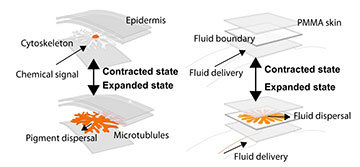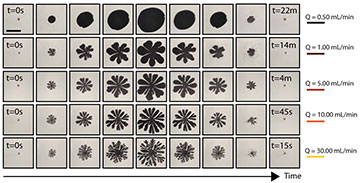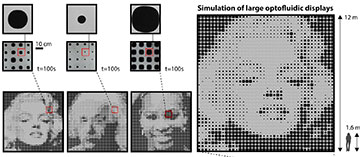The shading mechanism proposed by the University of Toronto team (right) mimics the optical response of krill skin (left). [Image: R. Kay et al. “Decapod-inspired pigment modulation for active building facades,” Nat. Commun. 13, 4120 (2022); CC BY 4.0] [Enlarge image]
Unlike temperature and daylight, which fluctuate at all hours, buildings are typically static structures. This inability to adapt to changing environmental factors leads to increased heating and cooling costs and energy consumption worldwide. Although some buildings rely on computer-controlled blinds or electrochromic windows to be more versatile, those methods are often insufficient.
Inspired by marine organisms such as crabs and krill, researchers from the University of Toronto, Canada, developed an adaptive building facade that tunes optical transmission using reversible fluid injections (Nat. Commun., doi: 10.1038/s41467-022-31527-6). Researchers write that the facade can reconfigure itself to find its optimal states, which could reduce the amount of energy spent on heating, cooling and lighting by over 30% compared with currently available electrochromic technologies, according to their models.
Inspired by krill
Antarctic krill (Euphausia superba) are shrimp-like marine animals that can change the color of their skin to protect themselves from UV light. Within minutes of a change in sunlight intensity, krill disperse pigments along radially branching microtubules under the epidermis, providing shade to their organs. This reversible process or other color-change mechanisms can also be found in other decapods such as prawn and crabs.
The injection rate of the carbon fluid determines the fluid pattern’s degree of branching. [Image: R. Kay et al. “Decapod-inspired pigment modulation for active building facades,” Nat. Commun. 13, 4120 (2022); CC BY 4.0] [Enlarge image]
Taking cues from such marine animals, the Toronto team set out to replicate and scale up the animals’ dynamic optical response for a material layer of a building’s facade. The researchers first built their prototype optofluidic cells using two transparent sheets of poly(methyl methacrylate) (PMMA) to sandwich a layer of mineral oil about 1 mm thick. Then, they injected a small amount of water-glycerol solution containing carbon particles—equivalent to krill’s pigments—into the center of the cell via a tube connected to a reversible digital pump.
By testing various injection rates, the researchers found they could control the shape of the blooming pattern created by the carbon-containing fluid. When the injection rate was low (0.50 mL/min), the fluid generated a circular pattern. As the rate increased, the fluid dispersed into intricate branching patterns, similar to the pigment patterns krill exhibit.
Digitally controlled
The researchers then set out to mimic marine organisms’ optical and thermal response. They fabricated a facade with 16 cells, each including a photosensor and a thermocouple, with independent injection sites. When the team shone a floodlight on the multicell facade, a digital negative-feedback system triggered the carbon fluid to be released, blocking excess light so that the only the preset amount of light could be transmitted.
When the researchers turned on a heat source to increase the temperature from 22 °C to 36 °C, the facade again reacted accordingly by dispersing the pigment fluid, providing shade and lowering the temperature back to 22 °C in 16 minutes.
In addition to the prototypes, the researchers built computer simulations that calculated how a fully automated and optimized system using their cells would perform compared with one that used motorized blinds or electrochromic windows.
“What we found is that our system could reduce the energy required for heating, cooling and lighting by up to 30% compared with the other two options,” said Raphael Kay, first author and master’s student at the University of Toronto, in a press release. “The main reason for this is that we have much finer control over the extent and timing of solar shading. Our system is analogous to opening and closing hundreds of tiny blinds at different locations and times across a facade.”
Energy-saving building design
The researchers demonstrated via computer simulations that the optofluidic cells could be used for artistic displays. Here, they created images of Marylin Monroe (left), Albert Einstein (middle) and Serena Williams (right). [Image: R. Kay et al. “Decapod-inspired pigment modulation for active building facades,” Nat. Commun. 13, 4120 (2022); CC BY 4.0] [Enlarge image]
In addition to improving energy efficiency of buildings, the researchers also suggest that their cells could be used for artwork, with each cell acting as a pixel. To demonstrate their vision, they used the computer model to simulate large digitized, optofluidic displays, creating faces of Marylin Monroe, Albert Einstein and Serena Williams.
Artistic possibilities aside, Benjamin Hatton, team lead and materials science and engineering professor at the University of Toronto, ultimately hopes that his team’s dynamic facade will shift conversations around both building design and climate change, according to the press release.
“Dynamic, adaptive buildings could reduce the temperature and daylight gradients that we have to push against, and potentially save a lot of energy,” Hatton said. “We hope our contribution will spark people’s imaginations.”



